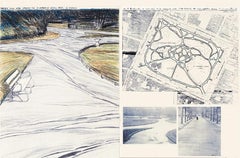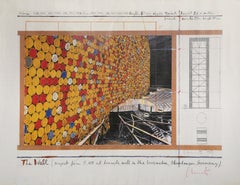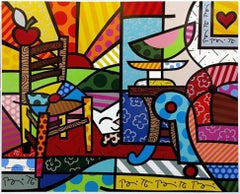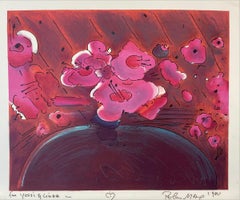Christo and Jeanne-Claude Interior Prints
Motivated solely by a mission to spread joy and celebrate beauty through their work, Christo and Jeanne-Claude (1935–2020; 1935–2009) created riveting large-scale public art installations that pushed ephemeral art to an entirely unprecedented new level. While the pair created prints, photography and a range of other types of art, they’re best known for their installations — working with a combination of textiles and industrial materials, Christo and Jeanne-Claude created colossal site-specific sculptures and other projects that frequently included wrapping monuments, walkways and even coastlines in reams of fabric in order to draw attention and encourage viewers to experience familiar objects and places in entirely new ways.
Christo and Jeanne-Claude frequently incorporated nature’s forces into their works, creating billowing fence lines, enormous inflatable free-standing structures and colorful floating walkways. Partners in life and art, the pair designed installations that often took years or even decades to realize and lasted for only days or weeks. Christo and Jeanne-Claude’s preparatory works and detailed drawings and collages are today a testament to their intricate ephemeral masterpieces and legacy.
Christo and Jeanne-Claude’s stories, incredibly, began on the exact same day — on June 13, 1935, Christo Vladimirov Javacheff was born in Gabrovo, Bulgaria, and on the very same day in Casablanca, Morocco, Jeanne-Claude Denat de Guillebon was born. While Jeanne-Claude received a broad education and a baccalauréat in Latin and philosophy, growing up in France, Switzerland, Morocco and Tunisia, Christo studied art from the age of six years old. He went on to study painting, drawing, architecture and sculpture at the National Academy of Art in Sofia before leaving Bulgaria to escape the Hungarian Revolution.
Christo spent time in Prague before a brief stint at the Vienna Academy of Fine Arts, moving on then to Geneva and ultimately France. He made money by painting portraits for wealthy families. After being hired by Jeanne-Claude’s mother to paint three portraits of her, Christo met his future wife and collaborator. The pair created their first environmental installation, Dockside Packages and Stacked Oil Barrels, in 1961.
Together, Christo and Jeanne-Claude pursued increasingly ambitious projects, proposing to wrap everything from trees in Wrapped Trees, Foundation Beyeler and Berower Park, Riehen, Switzerland, 1997-98 to important public buildings including the Wrapped Reichstag, Berlin, 1971–95. They also created free-standing abstract sculptures such as the 5,600 Cubicmeter Package, billowing curtains such as Valley Curtain, Rifle, Colorado, 1970–72, and proposed installations in locations as far-flung as Dubai and Japan. These projects and others have been linked to the Pop art-adjacent nouveau réalisme movement.
Classically trained in drawing, Christo created preparatory sketches and collages for the projects, selling his artwork to independently fund the monumental temporary installations the pair erected. Meanwhile, Jeanne-Claude advocated for the pair’s artwork, speaking at public forums, sending proposals to municipal governments, and using her unique combination of compelling charm and stoic stubbornness to get their projects approved.
Devoted to their ideals of spreading joy and beauty, the pair accepted no commissions or commercial collaborations — all their installations were funded purely by the sale of their preparatory art. The last of their realized urban works, that 2005 project invited New Yorkers to go for a glorious walk through 7,503 saffron-fabric-draped portals along the pathways of Central Park. More than 4 million people did.
Christo’s wrapped sculptures, which he began making early in his career, as well as his preparatory works, are held in the permanent collections of museums and other institutions including the Smithsonian American Art Museum, the National Gallery of Art, the Museum of Contemporary Art and the Centre Pompidou. Jeanne-Claude died in 2009, and Christo continued to realize the pair’s planned projects until his own passing in 2020.
Find original Christo and Jeanne-Claude photography, mixed media works, sculptures and prints on 1stDibs.
1980s Pop Art Christo and Jeanne-Claude Interior Prints
Board, Archival Paper, Lithograph
1990s Conceptual Christo and Jeanne-Claude Interior Prints
Offset
21st Century and Contemporary Pop Art Christo and Jeanne-Claude Interior Prints
Gesso, Board, Screen
1980s Pop Art Christo and Jeanne-Claude Interior Prints
Lithograph
1980s Pop Art Christo and Jeanne-Claude Interior Prints
Lithograph
2010s Contemporary Christo and Jeanne-Claude Interior Prints
Permanent Marker, Lithograph, Offset
1990s Pop Art Christo and Jeanne-Claude Interior Prints
Lithograph
Early 2000s Minimalist Christo and Jeanne-Claude Interior Prints
Permanent Marker, Lithograph, Offset
1970s Pop Art Christo and Jeanne-Claude Interior Prints
Lithograph
1960s Pop Art Christo and Jeanne-Claude Interior Prints
Lithograph
2010s Minimalist Christo and Jeanne-Claude Interior Prints
Lithograph, Offset, Permanent Marker
1980s Pop Art Christo and Jeanne-Claude Interior Prints
Lithograph, Offset
1980s Pop Art Christo and Jeanne-Claude Interior Prints
Lithograph, Offset
2010s Minimalist Christo and Jeanne-Claude Interior Prints
Permanent Marker, Lithograph, Offset
Christo And Jeanne-claude interior prints for sale on 1stDibs.
Artists Similar to Christo and Jeanne-Claude
- 1stDibs ExpertApril 5, 2022Christo and Jeanne-Claude wrapped things as a way of creating art. They took everyday objects and bound them in order to take away their functionality. In addition, they sought to preserve the items, similarly to the way the Ancient Egyptians did mummies. You'll find a variety of Christo and Jeanne-Claude art on 1stDibs.
- 1stDibs ExpertApril 5, 2022Christo and Jeanne-Claude, best known for their L’Arc de Triomphe, wrapped art piece in Paris, used recyclable polypropylene fabric for the wrapping. For other displays of art, Christo and Jeanne-Claude have used a variety of fabrics, including nylon. Shop a variety of Christo and Jeanne-Claude artwork from some of the world’s top sellers on 1stDibs.



